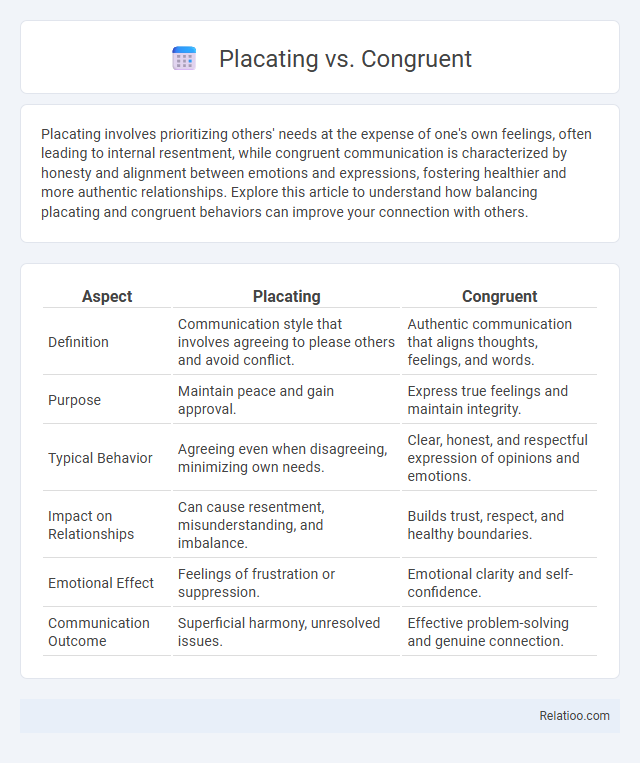Placating involves prioritizing others' needs at the expense of one's own feelings, often leading to internal resentment, while congruent communication is characterized by honesty and alignment between emotions and expressions, fostering healthier and more authentic relationships. Explore this article to understand how balancing placating and congruent behaviors can improve your connection with others.
Table of Comparison
| Aspect | Placating | Congruent |
|---|---|---|
| Definition | Communication style that involves agreeing to please others and avoid conflict. | Authentic communication that aligns thoughts, feelings, and words. |
| Purpose | Maintain peace and gain approval. | Express true feelings and maintain integrity. |
| Typical Behavior | Agreeing even when disagreeing, minimizing own needs. | Clear, honest, and respectful expression of opinions and emotions. |
| Impact on Relationships | Can cause resentment, misunderstanding, and imbalance. | Builds trust, respect, and healthy boundaries. |
| Emotional Effect | Feelings of frustration or suppression. | Emotional clarity and self-confidence. |
| Communication Outcome | Superficial harmony, unresolved issues. | Effective problem-solving and genuine connection. |
Understanding Placating and Congruence
Placating involves excessively accommodating others at the expense of one's own needs, often leading to resentment and loss of authenticity. Congruence refers to alignment between one's feelings, thoughts, and actions, fostering genuine communication and emotional well-being. Understanding placating versus congruence highlights the importance of maintaining personal boundaries while expressing true emotions to build healthier relationships.
Key Differences Between Placating and Congruent Communication
Placating communication involves agreeing or submitting to others to avoid conflict, often at the expense of one's own needs or feelings, while congruent communication reflects authentic, clear, and honest expression aligned with true thoughts and emotions. Placating tends to create imbalance and misunderstandings due to hidden resentment or unmet needs, whereas congruent communication fosters trust, mutual respect, and effective problem-solving. Understanding these key differences is crucial for improving interpersonal relationships and promoting healthy, transparent dialogue.
Psychological Roots of Placating Behavior
Placating behavior often stems from deep psychological roots such as low self-esteem, fear of conflict, and a strong need for approval, which can lead individuals to prioritize others' needs over their own. In contrast, congruent communication reflects authenticity and alignment between inner feelings and outward expressions, promoting healthy boundaries and self-respect. Understanding your tendency to placate enables you to foster more balanced interactions and develop assertive, congruent communication skills.
The Value of Congruent Communication
Congruent communication aligns your words, tone, and body language to express genuine feelings and thoughts, fostering trust and clarity in interactions. Placating often involves appeasing others at the expense of your own needs, leading to misunderstandings and diminished self-respect. Embracing congruent communication empowers you to establish authentic connections and navigate conflicts with confidence and integrity.
Effects of Placating on Relationships
Placating in relationships often leads to resentment and imbalance because one partner constantly sacrifices their needs to avoid conflict. This behavior can erode trust and communication, leaving Your emotional well-being compromised as true feelings are suppressed. Embracing congruence, where honesty and authenticity guide interactions, strengthens bonds and fosters mutual respect.
Benefits of Practicing Congruence
Practicing congruence fosters authentic communication by aligning thoughts, emotions, and actions, which enhances trust and strengthens relationships. Congruent behavior promotes emotional well-being and reduces internal conflicts by encouraging self-awareness and honesty. Unlike placating, which often sacrifices personal needs for approval, congruence nurtures mutual respect and empowers individuals to express genuine feelings effectively.
Identifying Placating Patterns in Conversations
Identifying placating patterns in conversations involves recognizing behaviors where one party consistently seeks to appease others at the expense of their own needs, often through excessive agreement, self-deprecation, or silence. Your awareness of such patterns helps distinguish placating responses from congruent communication, which is characterized by honest, clear expression aligned with one's genuine feelings and beliefs. Observing these interactions reveals how placating undermines authentic dialogue and may perpetuate imbalance in relationships.
Building Congruence: Practical Strategies
Building congruence involves aligning your words, actions, and emotions to create authentic and trustworthy interactions. Practical strategies to foster congruence include self-awareness practices, active listening, and honest communication that respects both your needs and those of others. You enhance relationships and reduce conflict by consistently expressing genuine feelings and setting clear boundaries without resorting to placating or aggressive behaviors.
Overcoming the Habit of Placating
Overcoming the habit of placating requires embracing congruent communication, where your feelings and needs align authentically with your words and actions. Placating often involves suppressing your own desires to avoid conflict, leading to internal frustration and strained relationships. You can develop congruence by practicing assertiveness, setting healthy boundaries, and valuing your own voice in interpersonal dynamics.
Choosing Congruence for Authentic Connection
Choosing congruence fosters authentic connection by aligning words, feelings, and actions, enhancing trust and clarity in communication. Placating often leads to superficial harmony but may sacrifice personal boundaries, while aggressive or blaming behaviors disrupt genuine interaction. Emphasizing congruence encourages true understanding and meaningful relationships built on honesty and respect.

Infographic: Placating vs Congruent
 relatioo.com
relatioo.com